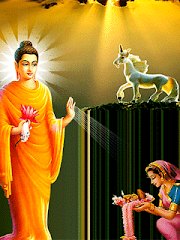Any of us have at one time or another found the toll of living in the modern world hard to bear. Stress, depression and disillusionment are some of the diseases of modern times that leave us yearning for a solution, a cure, so to speak. More and more people are turning to meditation as they fail to find the answer through worldly paths.
Meditation is found in some form or other in all major religious traditions. Even those who are not religious use it to focus the mind, to hone it, so that it works better. In Buddhism, meditation is the integral to the eight-fold path to enlightenment. One trains one’s mind so that it can see the four-point Supreme Truth that forms the core of Buddha’s teachings: suffering, what causes it, the end of suffering, and the path to that end. Even if you are not interested in Buddhism, meditation is a valuable training that can be applied to daily life, for it helps with concentration and when done correctly can lead to a state of peace and calmness that’s beyond worldly joys.
There are two main banches in Buddhist meditation: samatha (calmness, concentration) and vipassana (insight), which stresses mindfulness. This doesn’t mean that the two are entirely separate, since you cannot be mindful unless you have at least some level of concentration.
The techniques of samatha meditation are many, some older than Buddhism, others developed after the time of the Buddha. Among the most commonly practiced here is anapanasati, or “mindfulness with breathing.” This technique was advocated by the Venerable Buddhadasa Bhikku (1903-1993), founder of Suan Mokkh Forest Monastery in Surat Thani. Meditators at Suan Mokkh (Garden of Liberation), follow the 16 steps of anapanasati as laid down in Pali texts.
Mantra meditation, in which you repeat a few words over and over, is also widely practiced. Followers of this technique may chant “Buddh” as they inhale, and “dho” as they exhale. The words may vary, but the purpose of chanting is really to get the mind focused. Yet another widely taught technique is kasinas, where meditators concentrate on an object outside themselves, such as the flame of a candle, or a crystal ball.

Sati, or mindfulness, is key to vipassana meditation. You train yourself to be aware of the body’s action, the rise and fall of your chest as you inhale and exhale, the movement of your feet and legs as you walk, as well as your feelings, your thought, and finally, the state of mind you are in. Walking, sitting and lying meditation are but a few of vipassana techniques. When the mind is untrained, concentration can be shattered by the slightest stimuli -noise, smell, heat, hunger, pain, etc. The key is to become aware of what happens, but not dwell on it. Still, a novice can only ward off so much distraction, and that’s one reason why vipassana retreats are usually held in peaceful and isolated settings.
Meditation teachings are widely available in Thailand. You can attend a class at one of the teaching monasteries for an afternoon or evening. Wat Mahadhatu near the Grand Palace, for example, has two meditation training centers open to locals and tourists. Or you may join a vipassana retreat, which usually takes a weekend or longer. A number of retreat centers, most of them located in the provinces, run intensive courses of up to four weeks on an ongoing basis. All vipassana retreats require you to follow the Five Buddhist Precepts. These include refraining from harming all living beings, from taking what is not given, from improper sexual behavior, from lying and incorrect speech, and from taking liquors and drugs that will cloud the mind. Some retreats may require that you take you take the Eight Precepts, which in addition to the first five include refraining from dinner, from all forms of entertainment and bodily decoration, and from sleeping on high mattresses.


.gif)



